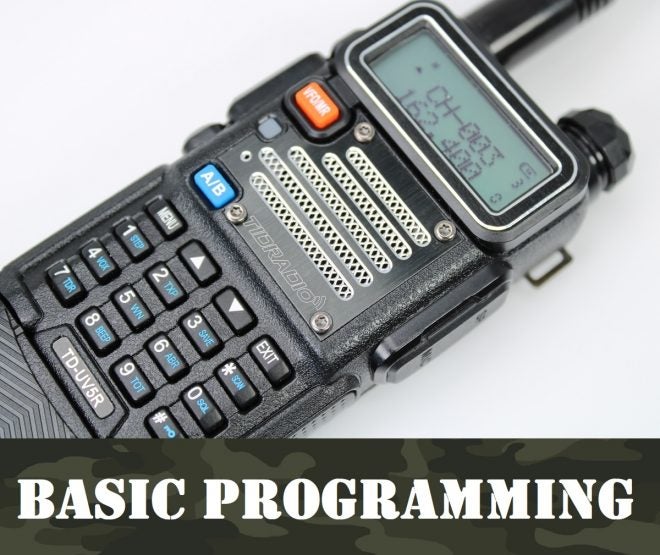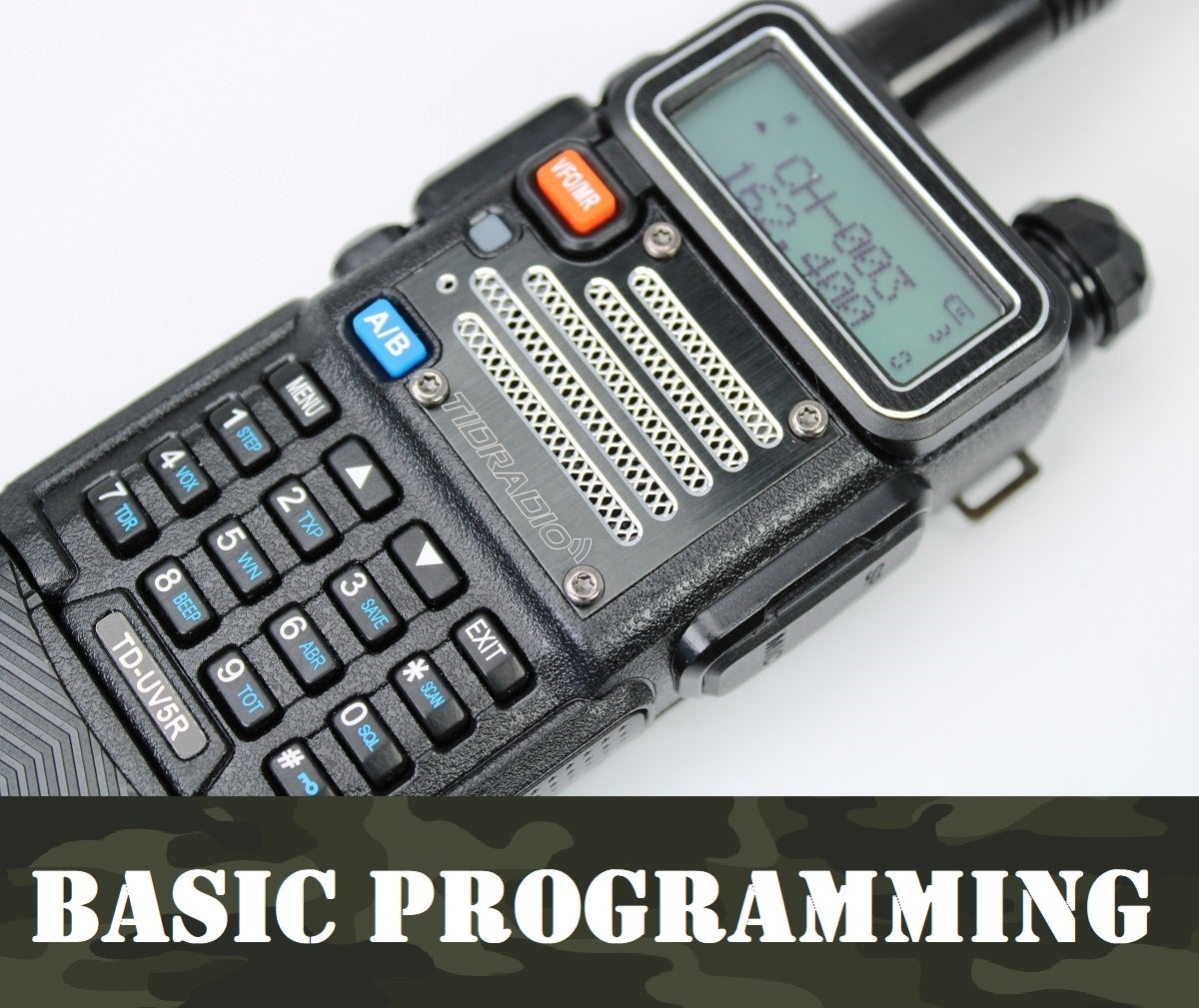The Ham Radio Guide: UV-5R Basic Radio Programming
Travis Olander 12.22.22

We’ve covered basic setup with the UV-5R, and how to use the menu and its 40 options. Now, let’s get into Basic Radio Programming. We’ll cover all the legal things you can do with a UV-5R without a Ham license. We’ll also cover how to program important frequencies, including emergency, EMS, and NOAA channels for those “SHTF” moments.
New to Ham Radio? Read Our Other Guides
- Part 1: Intro to Ham Radio and FAQs
- Part 2: Basic Radio Setup With a UV-5R
- Part 3: Navigating the UV-5R Menu
- Part 4: Basic Programming (you’re here!)
- Part 5: Advanced Programming (Repeaters and Tones)
Before programming frequencies, know these three rules:
- You can transmit unlicensed in an emergency.
- You can use your UV-5R to transmit without a license on any frequency in a real, life-threatening emergency. We still strongly recommend you get licensed. Read Part One of our guide to learn how. Many of the channels and configurations we cover in this guide require you to at least have a Technician License.
- You can receive on any freq without a license.
- If you’re not licensed, you can still program your UV-5R to receive on any frequency. But again, you can’t transmit without a license.
- You Can’t transmit on GMRS and FRS. Ever.
- The FCC says you cannot use a Ham radio to transmit on GMRS (General Mobile Radio Service) or FRS (Family Radio Service) bands. These two bands are reserved for short-range, narrowband Walkie-Talkies. You can only listen in on these bands with your UV-5R. This remains true even if you have a Ham license and/or a GMRS license. The GMRS license is different than a Ham license.
First, Program NOAA Channels
The National Weather Service (NWS) operates national radio channels 24/7. They provide weather alerts and emergency info. Let’s cover how to program and scan all seven NOAA channels.
List of NOAA Frequencies (VHF):
- 162.400
- 162.425
- 162.450
- 162.475
- 162.500
- 162.525
- 162.550
1. Press VFO/MR to enter Frequency Mode. If you see small digits to the right of the frequencies displayed on the screen, you’re in Channel Mode. In Frequency Mode you will not see these digits.
2. Cycle the A/B Button until the top line is selected. You can only save frequencies to channels if you’re using the top line on the main screen. A small arrow to the left of each line indicates whether you’re on top (A) or bottom (B).
3. Enter the frequency you wish to assign to a channel. Let’s start with 162.400. Enter the frequency on the main screen using the keypad.
4. Press MENU. Navigate to Menu Option #28. This allows you to clear the radio’s channel memory. Select which channel you want to save your frequency to (000 to 127) with the UP/DOWN arrows. Clear that channel by again pressing the MENU button. If you have the voice prompts enabled, the radio will say, “Confirmed.”
5. Navigate to Menu Option #27. This allows you to save the frequency to the channel you just cleared out. Press Menu again, and use the UP/DOWN arrows to select the channel of your choice. Press Menu again, and the channel will be saved with that frequency. The voice prompt will say, “receiving memory” when saving. Your frequency is now saved to the selected channel. You can confirm this by viewing the channel in Option #27. The assigned channel will display “CH-” before its number.
6. Repeat steps 4 and 5 to store the other NOAA channels. If the channel you want to use has “CH-” before it, it must be emptied with Option #28. You can now scan and monitor all NOAA channel for national broadcasts.
How to Scan on the UV-5R
To scan channels, press the VFO/MR button to enter Channel Mode. While on the main screen, press and hold the * (“SCAN”) button on the keypad. The top line on the screen will quickly cycle between all saved channels. Press EXIT to stop scanning. To force the radio to stay on a channel that’s broadcasting, open the menu. Navigate to Option #18 (SC-REV) and set this function to “SE”. The radio will now stop and remain on a channel that’s broadcasting until you navigate to another channel, or tell it to scan again.
To scan frequencies, press VFO/MR to enter Frequency Mode. Press and hold the * (“SCAN”) button, and the radio will scan all frequencies in the VHF and UHF bands. The “SE” function governs this type of scanning, too. To scan VHF frequencies (136 – 174 MHz), enter 136.000 using the keypad before scanning. To scan UHF frequencies (400 – 520 MHz), enter 400.000 before scanning.
Program MURS channels
Although it is technically against FCC regulations, these VHF channels are sometimes used by rebellious Hams and preppers. Follow the steps we provided above to save these frequencies to channels:
- 151.820 – MURS calling frequency
- 151.880 – Common repeater frequency
- 151.940 – Emergency channel
- 154.570 – Grandfathered business frequency (drive-thru)
- 154.600 – Grandfathered business frequency (drive-thru)
International Distress Channel
VHF Channel 16 is globally recognized as a universal emergency channel. Its frequency is 156.800 MHz. If rescue operations know that a person in distress has a radio, but they don’t know the radio’s setup, personnel will attempt to make contact on this frequency. All U.S Coast Guard and global maritime personnel monitor this frequency 24/7.
National Simplex Calling Frequencies
A national calling frequency is a widely accepted place to start communicating with other radio operators. If you establish a Mayday or SOS on these frequencies, you’re likely to get a response. They typically work anywhere in the U.S. For our UV-5R, compatible frequencies include:
- 146.250 – VHF
- 446.000 – UHF
Store Your Local Frequencies
Radio Reference is the ultimate database for radio frequencies. You can find many local repeaters and police, fire, dispatch, EMS, rescue, and other amateur operators’ channels. Note that only VHF and UHF results are compatible with the UV-5R. Many results are digital or trunked; these are incompatible, too. To access repeater information, you will need to pay and subscribe to the reference database ($30/year). To start, navigate to “Frequency Databases” in the top menu and enter your town, city, county, and/or state.
Other Useful Emergency Frequencies
- 156.050 – Port operations
- 156.350 – Commercial use
- 156.450 – Boater calling
- 156.500 – General commercial
- 156.700 – Port operations
- 156.850 – State and local government maritime
- 157.000 – Port operations
- 157.150 – U.S. Coast Guard only
- 157.125 – U.S. Government only
- 161.825 – Public correspondence
Now that you understand basic programming, read the final part of our guide to Ham Radio: Advanced Programming (Repeaters and Tones).
